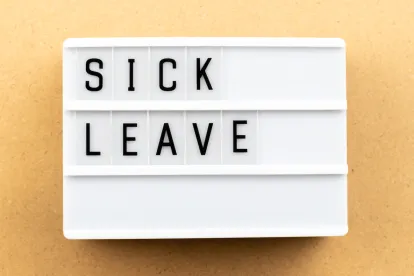Colorado has enacted the Healthy Families and Workplaces Act (SB20-205) (HFWA) to require employers to provide employees with up to six days, or up to 48 hours, of earned paid sick leave.
Employers with at least 16 employees must begin providing earned paid sick leave on January 1, 2021. All employers, regardless of size, must begin providing earned paid sick leave effective January 1, 2022.
Effective immediately, the HFWA requires that employers, regardless of size, comply with the federal Emergency Paid Sick Leave Act in the Families First Coronavirus Response Act (FFCRA), which stays in effect until December 31, 2020. The Emergency Paid Sick Leave Act provides up to 80 hours of sick leave for COVID-19-related reasons. The HFWA does not require employers to comply with the Emergency Family and Medical Leave Expansion Act of the FFCRA, which provides 12 weeks of pay to care for children whose school or place of care is closed, or childcare provider is unavailable, because of COVID-19-related reasons.
Colorado’s Division of Labor Standards and Statistics will have the authority to enforce the requirements of the HFWA. The Division will be providing rules regarding compensation and accrual of paid sick leave under the HFWA.
Employee Eligibility
Employees immediately begin to accrue paid sick leave upon hire and may use sick leave as soon as it is accrued.
How Employees Accrue Paid Sick Leave
Each employee earns at least one hour of paid sick leave for every 30 hours the employee works, up to 48 hours of paid sick leave per year, unless the employer selects a higher limit.
An employer may satisfy the accrual requirements of the HFWA by providing the employee with an amount of paid sick leave that meets or exceeds the requirements of the HFWA at the beginning of the year.
Exempt employees who work less than a 40-hour workweek accrue paid sick leave based on the number of hours that comprise the employee’s normal workweek.
Reasons for Taking Accrued Paid Sick Leave
Employees may use accrued paid sick leave for the following reasons:
The employee:
(i) Has a mental or physical illness, injury, or health condition that prevents the employee from working;
(ii) Needs to obtain a medical diagnosis, care, or treatment of a mental or physical illness, injury, or health condition; or
(iii) Needs to obtain preventive medical care.
The employee needs to care for a family member who:
(i) Has a mental or physical illness, injury, or health condition;
(ii) Needs to obtain a medical diagnosis, care, or treatment of a mental or physical illness, injury, or health condition; or
(iii) Needs to obtain preventive medical care.
The employee or the employee’s family member has been the victim of domestic abuse, sexual assault, or harassment and the use of leave is to:
(i) Seek medical attention for the employee or the employee’s family member to recover from a mental or physical illness, injury, or health condition caused by the domestic abuse, sexual assault, or harassment;
(ii) Obtain services from a victim services organization;
(iii) Obtain mental health or other counseling;
(iv) Seek relocation due to the domestic abuse, sexual assault, or harassment; or
(v) Seek legal services, including preparation for or participation in a civil or criminal proceeding relating to or resulting from the domestic abuse, sexual assault, or harassment;
Due to a public health emergency, a public official has ordered closure of:
(i) The employee’s place of business; or
(ii) The school or place of care of the employee’s child and the employee needs to be absent from work to care for the employee’s child.
Taking Paid Sick Leave
Employees must take paid sick leave in one-hour increments, unless the employer permits employees to take leave in smaller increments. Employers may loan paid sick leave to an employee who has not yet accrued it.
Employers may not require, as a condition of taking paid sick leave, that the employee search for and find a replacement worker to cover the employee’s paid sick leave.
Requests for accrued paid sick leave must be made orally, in writing, electronically, or by any other means acceptable to the employer. When possible, the employee must include the expected duration of the absence. An employer may adopt a written policy that contains reasonable procedures for the employee to provide notice when the use of paid sick leave taken under the HFWA is foreseeable; however, an employer cannot deny paid sick leave to the employee based on noncompliance with such a policy. When the leave is foreseeable, employees should make a good faith effort to provide notice to the employer and make a reasonable effort to schedule paid sick leave in a manner that does not unduly disrupt business operations.
Carry Over of Accrued Paid Sick Leave
Employees may carry over up to 48 hours of unused paid sick leave to the following year; however, employers can limit the amount of leave an employee may take in any year to 48 hours.
Paid Sick Leave at Separation
The HFWA does not create an obligation for employers to pay out unused, accrued paid sick leave at separation, regardless of the reason for separation.
However, an individual may recover paid sick leave as a remedy for a retaliatory personnel action that prevented the individual from using paid sick leave.
Additionally, if an employer rehires a separated employee within six months of that employee’s separation, the employer must reinstate any unused, accrued paid sick leave the employee had during the employee’s previous employment.
Paid Sick Leave and Public Health Emergencies (e.g., COVID-19)
In addition to the paid sick leave accrued as described above, employees are entitled to a one-time grant of leave in the event of a “public health emergency.”
A public health emergency is defined as an act of bioterrorism, a pandemic influenza, or an epidemic caused by a novel and highly fatal infectious act, for which: (1) a disaster emergency is declared by the governor; or (2) an emergency is declared by a federal, state, or local public health agency; or (3) a highly infectious illness or agent with epidemic or pandemic potential for which a disaster emergency is declared by the governor.
To ensure employees may take paid sick leave for the reasons below, employers must supplement employees’ accrued paid sick leave as necessary (at least 80 hours for employees who work at least 40 hours a week; for employees who work fewer than 40 hours a week, the amount of time the employee is scheduled to work or the average of what the employee actually works in a 14-day period, whichever is greater):
An employee’s need to:
(i) Self-isolate and care for oneself because the employee is diagnosed with a communicable illness that is the cause of a public health emergency;
(ii) Self-isolate and care for oneself because the employee is experiencing symptoms of a communicable illness that is the cause of a public health emergency;
(iii) Seek or obtain medical diagnosis, care, or treatment if experiencing symptoms of a communicable illness that is the cause of a public health emergency;
(iv) Seek preventive care concerning a communicable illness that is the cause of a public health emergency; or
(v) Care for a family member who:
(a) Is self-isolating after being diagnosed with a communicable illness that is the cause of a public health emergency;
(b) Is self-isolating due to experiencing symptoms of a communicable illness that is the cause of a public health emergency;
(c) Needs medical diagnosis, care, or treatment if experiencing symptoms of a communicable illness that is the cause of a public health emergency; or
(d) Is seeking preventive care concerning a communicable illness that is the cause of a public health emergency;
Or if:
(i) A local, state, or federal public official or health authority having jurisdiction over the location in which the employee’s place of employment is located or the employee’s employer determines that the employee’s presence on the job or in the community would jeopardize the health of others because of the employee’s exposure to the communicable illness or because the employee is exhibiting symptoms of the communicable illness, regardless of whether the employee has been diagnosed with the communicable illness;
Or to:
(ii) Care for a family member after a local, state, or federal public official or health authority having jurisdiction over the location in which the family member’s place of employment is located or the family member’s employer determines that the family member’s presence on the job or in the community would jeopardize the health of others because of the family member’s exposure to the communicable illness or because the family member is exhibiting symptoms of the communicable illness, regardless of whether the family member has been diagnosed with the communicable illness;
(iii) Care for a child or other family member when the individual’s child care provider is unavailable due to a public health emergency, or if the child’s or family member’s school or place of care has been closed by a local, state, or federal public official or at the discretion of the school or place of care due to a public health emergency, including if a school or place of care is physically closed but providing instruction remotely;
Or due to:
(iv) An employee’s inability to work because the employee has a health condition that may increase susceptibility to or risk of a communicable illness that is the cause of the public health emergency.
Employers may count an employee’s unused, accrued paid time off toward this supplemental leave. Employers may not require documentation for taking this leave and employees may use this leave up until four weeks after the official termination or suspension of the public health emergency.
Recordkeeping
Employers must retain records for each employee for a two-year period, documenting hours worked, paid sick leave accrued, and paid sick leave used.
Anti-Retaliation
The HFWA prohibits retaliation against employees who take this leave, providing an avenue of relief if employees feel their employer has taken any adverse action against them.
Violations of the HFWA includes compensating an employee until the employee is reinstated or, if reinstatement is not feasible, for a reasonable period.
An employer who willfully retaliates against an employee will be subject to a civil fine of up to $100 for each separate violation.
Aggrieved individuals also may file a civil action after submitting a complaint to the Division or after making a written demand for compensation or other relief to the employer. An employer has 14 days to respond after receiving a notice from the Division that a complaint has been filed with it or a written demand from the aggrieved person.
Notice to Employees
Employers must notify its employees, in writing, that they are entitled to paid sick leave, in accordance with the rules that will be promulgated by the Division. Employers must immediately post the Colorado Workplace Public Health Rights Poster and distribute to employees the Division’s Interpretive Notice & Formal Opinion #6A. Employers also must provide notices and posters in any language that is the first language spoken by at least five percent of its workforce.
Additional posters and notices will be made available to employers to comply with these notice requirements for 2021.
Colorado Health Emergency Leave with Pay (HELP) Rules Terminated
Colorado’s HELP Rules are no longer in effect. The HELP Rules were adopted and effective on March 11, 2020, and were to remain in effect for 30 days or the duration of the state of disaster emergency declared by the Governor up 120 days, whichever is greater. The Division terminated the requirements of the HELP Rules on July 14, the day before the HFWA went into effect.
The HELP Rules required employers to provide up to two weeks (up to a maximum of 80 hours) of paid sick leave at two-thirds of the employee’s regular rate of pay to employees with flu-like or respiratory illness symptoms who are being tested for COVID-19 or who are under instruction from a healthcare provider or authorized government official to quarantine or isolate due to a risk of having COVID-19.





 />i
/>i

